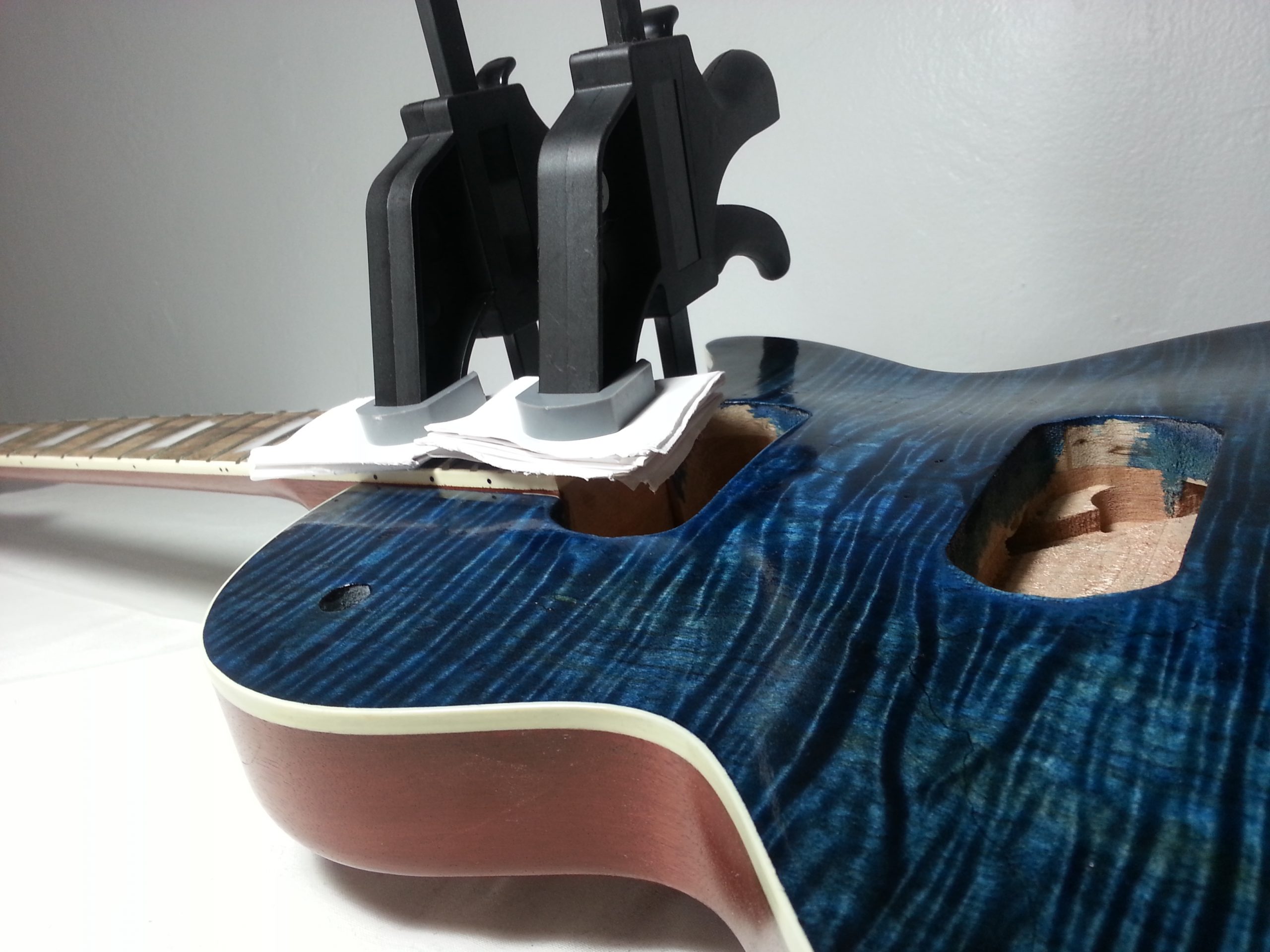Which is better? To buy a guitar with a bolt-on neck or one with a glued neck? Should I glue the neck of my guitar? What kind of glue is best for my guitar’s neck? These and many more are questions beginner guitarists always ask.
First, it’s crucial to understand that whether or not you use glue on your guitar necks will depend on your personal preferences in terms of tone and playing technique.
As a general rule, you should use a glued or set neck guitar if you like warmer and fuller tones. However, they can be harder to repair or reset, hence making the bolt-on neck more advantageous at this point.
Allow me to provide you with a detailed response to this question as well as, give some other facts regarding guitar necks, the most preferred glues, and step-by-step instructions on how to glue your guitar and even install a bolt-on neck.
Pros & Cons Of Using Glue For Guitar Necks
First, using glue for the guitar neck is called a set-neck construction. This describes the construction of the guitar neck whereby the guitar body is built separately from the neck and afterwards attached with glue. Below are pros & cons of using glue for guitar necks.
Pros of using glue for guitar necks:
- Glue for guitar neck results in broader, warmer, and more luscious tones.
- Glued guitar necks are a requirement for luxury producers.
- Glued guitar necks (set necks) have beautiful aesthetics.
- Due to the design of glued guitar necks, they make it simpler to reach the upper frets.
Cons of using glue for guitar necks:
- Guitars that have been glued are nearly impossible to fix.
- Glued guitar necks are more expensive than bolt-on necks because of the production costs.
- Over time, glued guitar necks may lose their effectiveness.
- Glued guitar necks are more fragile and prone to easily breaking.
Should You Glue Guitar Necks?
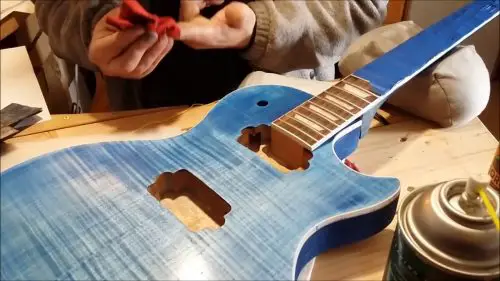
If you want a richer and warm sound of guitar then you should use a glued guitar neck
You should use a glued guitar neck (set neck) if you prefer a guitar with a warm, richer sound.
A neck-through will be best for you if you are more concerned with the durability factor of your guitar and the outstanding resonance it can offer.
On the other hand, you should choose a bolt-on neck if you like a sharper tone, ease of maintenance and want to be able to swiftly and affordably replace your guitar’s neck joint.
It all boils down to choice. Analyzing the unique demands and preferences of a particular guitarist is necessary to determine whether glued or bolted neck joints will best suit that player.
Having stated the advantages of each of the three types of neck joints, I suggest letting the player determine which neck joint is best for them. What guitar tone you prefer and what your expectations are for your next instrument.
Because of their distinct tonality due to their design, none of the neck joints stated is better or worse than the others. You should therefore be aware of the sound kind and take the guitar’s reparability into account.
Can You Glue a Bolt-on Neck?
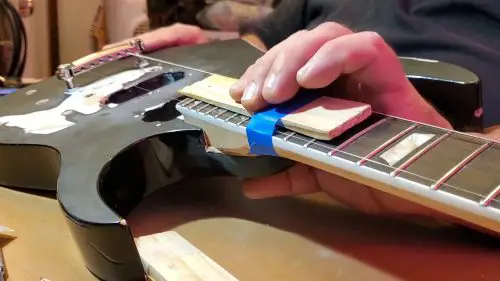
If your cavity is snug and nice you could glue in a bolt on neck
If your cavity is nice and snug, you could glue in a bolt-on neck. But it’s not recommended because the majority of glued-in necks have a tenon that extends beneath their neck pickup, which may make it a little more difficult and risky.
So, without bolts or nuts, it could be simply glued together and would likely continue to function properly for several years.
However, you should also be prepared to deal with the potential result that may occur in time if you don’t get the precise geometry for correct fixing.
You only get one chance at getting the geometry precisely perfect. If you miss it, you will inevitably run across these two problems (risks of gluing bolt-on neck):
1. Unstable neck.
When gluing in a bolt-on neck, there are some restrictions on how much material may be removed from the heel without negatively impacting the joint’s stability.
When the joint stability is negatively impacted, you won’t be able to steam the neck apart and correct it since the pocket is in the wrong form.
2. Poor resale value.
Glue will not improve a correctly installed bolt-on neck joint. If the change was not done cleanly or correctly, it could kill the instrument’s resale value in addition to affecting playability. Hence, ultimately proves to be useless as a result.
I advise sticking to glue-on-glue and bolts-on-bolts during repairs but if you must glue on a bolt-on, make sure the neck pocket fits perfectly around the neck.
How Do You Put a Bolt-on a Neck?
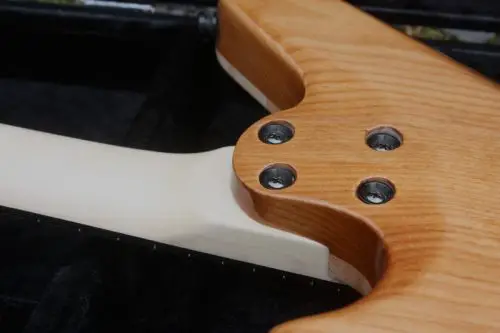
Bolt on guitar necks are way easier to install
Bolt-on necks are way easier to install. Unlike other neck joint types, you can simply fix them up yourself. To put a bolt-on neck;
STEP 1: CHOOSE A NECK BLANK.
Neck blanks are measured wood pieces that are capable of helping you build ideal guitar necks. You purchase them based on the desired measurement you would want your guitar necks to have. Hence choose a neck blank that has a corresponding fitting to your desired guitar neck.
STEP 2: MARK THE CENTERLINE OF THE NECK
You must mark the neck’s centerline once you’ve selected your neck blank. This is the line that will connect the guitar’s nut to the body. The centerline can be marked using a pencil or a pen.
STEP 3: CUT THE NECK BLANK TO THE APPROPRIATE LENGTH
The length usually varies depending on the type of guitar neck you are creating. Since it is a bolt-on neck, cut the blank to roughly 25 inches.
STEP 4: DRILL PILOT HOLES FOR BOLTS
Drill the pilot holes for the bolts once you have cut the neck blank to the proper length. Drill the pilot holes about 1/8 of an inch from the edge of the neck blank.
STEP 5: THREAD THE BOLTS INTO THE HOLES
The bolts need to be threaded into the holes in this place. The bolts should have a diameter of roughly 1/4 inch.
STEP 6: ATTACH THE NECK TO THE BODY OF THE GUITAR
To accomplish this, screw the bolts into the guitar’s body. Use washers to seal the space between the guitar’s body and the bolts. By doing so, the force will be evenly dispersed and the bolts won’t remove the wood.
You can begin working on your project now that you are aware of how to construct a bolt-on neck. Just remember to take your time, and measure twice before cutting.
Also Read: Installing Longer Guitar Neck: Can 21 Fret Neck Fits 22 or 24?
How Do You Glue a Guitar Neck?
STEP 1: IDENTIFY THE ISSUE
Try to identify the problem’s root cause before you start the remedy. Was the guitar accidentally dropped? or is it an issue of poor string assembly? In this situation, let’s assume it’s a case of a broken neck.
STEP 2: CLEAN
First, you would need to scrape off the former glue in the broken area. You can make use of a scraper, a utility knife, and a sharp chisel.
Use whichever suits you. However, when cleaning, make an effort to reduce the amount of finish damage as possible.
STEP 3: APPLY GLUE
Apply adhesive to the body and neck simultaneously while instinctively determining the parts where the glue should touch.
You should use a lot of adhesive because the extra will eventually squeeze out but if the glue is insufficient, it can cause weakening of the joint due to the cavities created.
STEP 4: CLAMP
You might observe that the fingerboard and the heel will need to be secured with a clamp. Hence, clamp the neck in place after fitting it.
To evenly spread the clamps’ pressure, utilize pieces of wood. You can place a folded cotton rag on the heel, which is round and tough to grasp, to lessen slipping. Remove any visible extra glue using a cloth and leave overnight to dry.
Best Glue For Guitar Neck
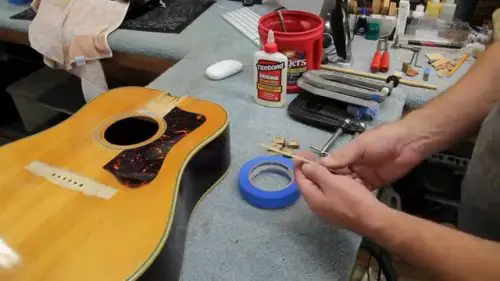
TiteBond original wood glue is the best option for repairing guitar neck
I would recommend the TiteBond Original Wood Glue. Due to how simple it is to use, it is undoubtedly my favorite. It sets quickly, but not too soon, attaches nicely, and is simple to clean up.
It can be released by hot water or steam, as in the case of a neck repair, and it is water resistant and stable in high humidity once set.
The “Titebond Original Wood Glue” is a special item. This is accepted as the industry standard for applications in general woodworking.
For more than 50 years, experts have favored using this original aliphatic-resin glue. It offers a strong initial tack and quick set speed to shorten clamp time.This glue delivers great standability, forms a bond stronger than the wood itself, and is unaffected by coatings.
It offers great heat, solvent, and mildew resistance. Both hardwoods and softwoods, as well as the majority of other porous materials, respond well to it.
Titebond Original Wood Glue is simple to use, non-toxic, devoid of solvents, and water-soluble. It is ready to use right out of the bottle, unlike Hide glue.
FAQs
Can You Remove a Glued Guitar Neck?
It is possible to remove a glued guitar neck by gently heating the junction with a hairdryer before prying the neck off. To assist pry the neck off, you might need to use a putty knife or another thin instrument.
However, because a guitar is so delicate, it is important to take care not to harm the body of the instrument while at it.


